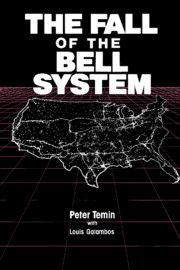Book contents
2 - Competition comes to the Bell System
Published online by Cambridge University Press: 06 January 2010
Summary
The great TELPAK controversy
AT&T's difficulties in the late 1950s started slowly, almost symbolically, in a tiny corner of the telephone business: private lines. As the term “private lines” indicates, these were lines not connected to the switched telephone network, but rather dedicated to the private use of parties who wanted to communicate frequently over specified pathways (e.g., business customers who had to call their branch offices frequently). The Bell System had provided private lines for large customers for many years, but this minor service earned only about 0.5 percent of the Bell System's total revenue. In November 1956 – shortly after the signing of the Consent Degree – the FCC decided to consider whether the private line business should be changed by allowing microwave systems employing radio frequencies above 890 megahertz to be used by private (i.e., non-Bell) parties. The increased sophistication of radio technology had made microwave radio eminently suitable for private lines. Potential users were asking the Commission for permission to build their own microwave systems instead of using AT&T's facilities.
Prominent among these users were the TV networks. They had grown rapidly in the postwar years, and they were heavy users of point-to-point telecommunications services to transmit their programming before sending it out over the air. A TV signal, after all, contains a lot of information. The FCC was eager to foster the growth of this new form of communication. In fact, the Commission was far more concerned about the growth of broadcasting, which it regulated under Title 3 of the Communications Act, than of point-to-point telecommunications, which it regulated under Title 2.
- Type
- Chapter
- Information
- The Fall of the Bell SystemA Study in Prices and Politics, pp. 28 - 69Publisher: Cambridge University PressPrint publication year: 1987



